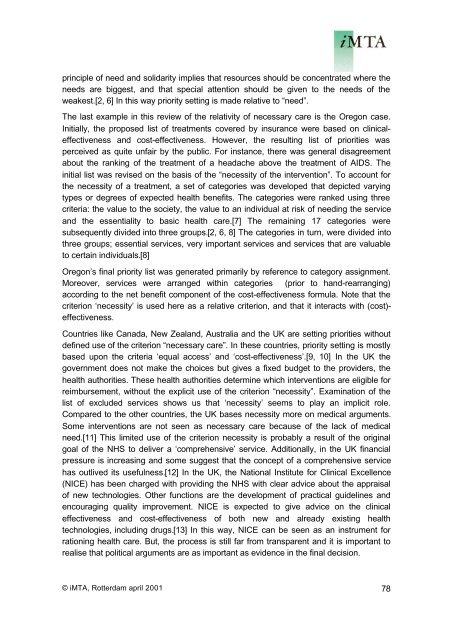Breedte geneesmiddelenpakket - Index of
Breedte geneesmiddelenpakket - Index of
Breedte geneesmiddelenpakket - Index of
You also want an ePaper? Increase the reach of your titles
YUMPU automatically turns print PDFs into web optimized ePapers that Google loves.
principle <strong>of</strong> need and solidarity implies that resources should be concentrated where the<br />
needs are biggest, and that special attention should be given to the needs <strong>of</strong> the<br />
weakest.[2, 6] In this way priority setting is made relative to “need”.<br />
The last example in this review <strong>of</strong> the relativity <strong>of</strong> necessary care is the Oregon case.<br />
Initially, the proposed list <strong>of</strong> treatments covered by insurance were based on clinicaleffectiveness<br />
and cost-effectiveness. However, the resulting list <strong>of</strong> priorities was<br />
perceived as quite unfair by the public. For instance, there was general disagreement<br />
about the ranking <strong>of</strong> the treatment <strong>of</strong> a headache above the treatment <strong>of</strong> AIDS. The<br />
initial list was revised on the basis <strong>of</strong> the “necessity <strong>of</strong> the intervention”. To account for<br />
the necessity <strong>of</strong> a treatment, a set <strong>of</strong> categories was developed that depicted varying<br />
types or degrees <strong>of</strong> expected health benefits. The categories were ranked using three<br />
criteria: the value to the society, the value to an individual at risk <strong>of</strong> needing the service<br />
and the essentiality to basic health care.[7] The remaining 17 categories were<br />
subsequently divided into three groups.[2, 6, 8] The categories in turn, were divided into<br />
three groups; essential services, very important services and services that are valuable<br />
to certain individuals.[8]<br />
Oregon’s final priority list was generated primarily by reference to category assignment.<br />
Moreover, services were arranged within categories (prior to hand-rearranging)<br />
according to the net benefit component <strong>of</strong> the cost-effectiveness formula. Note that the<br />
criterion ‘necessity’ is used here as a relative criterion, and that it interacts with (cost)effectiveness.<br />
Countries like Canada, New Zealand, Australia and the UK are setting priorities without<br />
defined use <strong>of</strong> the criterion “necessary care”. In these countries, priority setting is mostly<br />
based upon the criteria ‘equal access’ and ‘cost-effectiveness’.[9, 10] In the UK the<br />
government does not make the choices but gives a fixed budget to the providers, the<br />
health authorities. These health authorities determine which interventions are eligible for<br />
reimbursement, without the explicit use <strong>of</strong> the criterion “necessity”. Examination <strong>of</strong> the<br />
list <strong>of</strong> excluded services shows us that ‘necessity’ seems to play an implicit role.<br />
Compared to the other countries, the UK bases necessity more on medical arguments.<br />
Some interventions are not seen as necessary care because <strong>of</strong> the lack <strong>of</strong> medical<br />
need.[11] This limited use <strong>of</strong> the criterion necessity is probably a result <strong>of</strong> the original<br />
goal <strong>of</strong> the NHS to deliver a ‘comprehensive’ service. Additionally, in the UK financial<br />
pressure is increasing and some suggest that the concept <strong>of</strong> a comprehensive service<br />
has outlived its usefulness.[12] In the UK, the National Institute for Clinical Excellence<br />
(NICE) has been charged with providing the NHS with clear advice about the appraisal<br />
<strong>of</strong> new technologies. Other functions are the development <strong>of</strong> practical guidelines and<br />
encouraging quality improvement. NICE is expected to give advice on the clinical<br />
effectiveness and cost-effectiveness <strong>of</strong> both new and already existing health<br />
technologies, including drugs.[13] In this way, NICE can be seen as an instrument for<br />
rationing health care. But, the process is still far from transparent and it is important to<br />
realise that political arguments are as important as evidence in the final decision.<br />
© iMTA, Rotterdam april 2001 78


